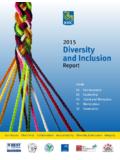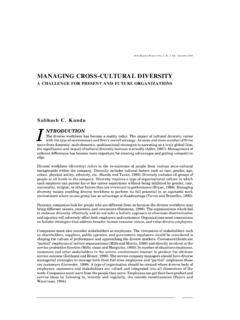Transcription of CULTURAL DIVERSITY: AN ALTERNATIVE APPROACH TO ...
1 The SMART Journal Spring/Summer 2008 Volume 4, Issue 2 Page 58 INTRODUCTION A growing body of literature has focused on how sport organizations might manage diversity in the workforce (Cunningham, 2007a; Cunningham, 2007b; Cunningham & Sagas, 2004; Doherty & Chelladurai, 1999; Fink, Pastore, & Riemer, 2001). Another growing body of research has begun to examine sport marketers efforts to reach a more diverse fan/spectator consumer base (Armstrong, 1998; Armstrong & Stratta, 2004; McCarthy, 1998). An extensive body of research in sport sociology has attempted to provide explanations for differential participation patterns in sport based on race and gender (Goldsmith, 2003; Harrison, Lee, & Belcher, 1999). Most of these researchers have identified socio-structural concerns as causes for a lack of diversity , such as environmental barriers and socio-economic status, as well as discrimination itself.
2 However, little research exists that specifically examines diversity considerations in the context of marketing and promoting sport participation to primary consumers. This paper seeks to establish the importance of conducting culturally sensitive consumer behavior research in order to more effectively promote sport participation by ethnically and culturally diverse consumer groups. THE IMPORTANCE OF diversity Culture is a complex concept that encompasses shared ways of achieving meaning in people s lives. According to Coakley, culture consists of the ways of life that people create as they participate in a group or society (2007, p. 5). Culture thus includes ethnicity that is, the CULTURAL heritage of a particular group of people (Cunningham, 2007a, p. 83) along with such things as the different meanings different groups attach to social undertakings like sport.
3 diversity is also a complex notion that entails differences of many types, including physical attributes ( , race, sex, age, physical ability), social attributes ( , education, income level), and CULTURAL attributes ( , beliefs, values, preferences). In addition to actual differences, perceptions of difference may play a role in diversity (van Knippenberg, De Drue, & Homan, 2004). Such differences may make a difference in organizational outcomes by affecting individual performance within a group, as well as group creativity and cohesion. Thus, diversity is perhaps best defined as the presence of differences among members of a social unit that lead to perceptions of such differences and that (Cunningham, 2007a, p. 6). diversity thus includes both demographic differences and CULTURAL differences.
4 According to Cunningham (2007a), these types of differences are likely to be interdependent, so managing diversity involves attending to both demographic and CULTURAL diversity as interrelated phenomena. In recent years, scholars have documented an awareness of the importance of increasing and successfully managing diversity in sport. This interest has been fueled by the recognition of legislative changes requiring equity as well as by rapidly changing demographics in America. Recent projections based on demographic data indicate that by the year 2007, the spending power of ethnic minority groups in the United States will CULTURAL diversity : AN ALTERNATIVE APPROACH TO UNDERSTANDING SPORT PARTICIPANT CONSUMER BEHAVIOR CATHRYN L. CLAUSSEN, JD, WASHINGTON STATE UNIVERSITY YONG JAE KO, PHD, UNIVERSITY OF FLORIDA ROBERT E.
5 RINEHART, PHD, WASHINGTON STATE UNIVERSITY The SMART Journal Spring/Summer 2008 Volume 4, Issue 2 Page 59 exceed $2 trillion, and that % of the American population will be comprised of people from non-white ethnic groups by the year 2050 (Willis, 2004). As a result of these legislative changes and demographic trends, sport organizations have begun to explore ways to meet the demands of an increasingly diverse pool of potential employees, fans, and participants. Typically, responses to the rising demand for accommodating increasing diversity come from two perspectives: a moral imperative or a business justification. Based on notions of social justice and ethically fair treatment of individuals, some scholars have called for sport organizations to proactively manage diversity simply because it is the right thing to do (DeSensi, 1994; Mai-Dalton, 1993).
6 In the United States, legal barriers to sport opportunities have been removed by the passage of several federal anti-discrimination statutes including the Civil Rights Act of 1964, Title IX of the Education Amendments of 1972, the Age Discrimination in Employment Act, the Americans with Disabilities Act of 1990, and section 504 of the Rehabilitation Act of 1973. Additionally, progress has been achieved by the courts as they have decided cases interpreting constitutional and civil rights in the context of access to opportunities in sport. However, ethical considerations can and often should go beyond minimum levels of barrier removal required by the law. While breaking barriers may partly overcome an ethnocentric worldview in which one CULTURAL perspective is preferred and naturalized, eliminating exclusiveness falls short of embracing inclusiveness.
7 According to Donnelly and Coakley (2002), physical activity providers ought to strive to be socially inclusive which means going beyond merely removing barriers to participation to attempting to ensure that all potential participants are valued and respected. DeSensi (1995) asserts that sport organizations need to move beyond ethno-relativism, in which difference is accepted and adapted to, to a state of true integration in which differences are valued and promoted. While the aforementioned scholars ground their recommendations in the existence of a moral imperative, others advocate greater effort to increase and manage diversity in order to further the survival and profit needs of sport organizations as business entities. They suggest that diversity is an asset that can be used strategically to gain a competitive business advantage (Fink, Pastore, & Riemer, 2001).
8 An increasingly diverse society presents untapped new markets for sport organizations to target (Armstrong, 1998; Brenner, 2004; McCarthy, 1998). Greenwald and Fernandez-Balboa (1998) suggest that sport sponsors are beginning to de-emphasize elite sport and celebrity endorsements; instead, they are turning to grassroots sports phenomena, with a focus on local communities and participants rather than spectators, in order to gain long-term benefits by marketing to youth who will eventually become the major consuming audience. Moreover, sponsoring grassroots special events allows companies to target certain demographics and psychographics that are not easily reached due to market fragmentation resulting in part from increasing ethnic and CULTURAL differences (Greenwald & Fernandez-Balboa, 1998).
9 Thus, diversity initiatives are gaining acceptance as sound business and marketing strategies. The 2000 United States Census indicates that of the population is comprised of Hispanics, black non-Hispanics, and Asians (Brenner, 2004). According to Brenner, there is one certainty for any league with national reach and every team and event in a market with a significant ethnic population: If you don t have a multi- CULTURAL marketing strategy now, you re missing the boat (p. 16). OBSTACLES IN MEETING THE CHALLENGES OF diversity The literature refers to three types of obstacles to successfully meeting the challenges of diversity in sport: difference itself, resistance, and failure to acknowledge the complex role of CULTURAL (as opposed to merely demographic) diversity . Difference itself is problematic because of the tendency of people to prefer to interact with others they perceive as like themselves with respect to both values and demographic characteristics, or who belong to their self-defined in-group (Cunningham & Sagas, 2004).
10 According to Cunningham and Sagas (2004), these homosocial forces contribute to a lack of unity unless difference is embraced or de-categorization of individuals occurs through increased interpersonal communication. The SMART Journal Spring/Summer 2008 Volume 4, Issue 2 Page 60 Resistance, both to diversity measures themselves and to change in general, is another obstacle to accommodating diversity . Organizational culture is not quickly or easily manipulated and changed, because it involves understanding and sharing basic values and assumptions about the organization (Doherty & Chelladurai, 1999, p. 293). Additionally, individuals have many reasons for resisting change, including emotional, social, status, economic, security, and perceived competence concerns (Gray & Starke, 1988). Thus, an organization s leadership cannot simply dictate successful culture change; rather, organizational culture is an ever-evolving, negotiated outcome of various intra-organizational interactions and shared experiences (Doherty & Chelladurai, 1999).









